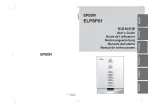
I/O AND CONTROL OPERATIONS
MAINS IN -
Powercon® NAC3FCA power input connector (blue). To switch the amplifier on, insert the Powercon®
connector and turn it clockwise into the ON position. To switch the amplifier off, pull back the switch on the connector
and turn it counter-clockwise into the POWER OFF position.
WARNING!
In the case of product failure or fuse replacement, disconnect the unit completely from the
mains power. The power cable must only be connected to a socket corresponding to the specifications
indicated on the amplifier unit. The power supply must be protected by a suitably rated thermo-magnetic
breaker.
Preferably use a suitable switch to power on the whole audio system leaving the Powercon® always
connected to each speaker, this simple trick extend the life of the Powercon® connectors.
MAINS OUT -
Powercon® NAC3FCB power output connector (grey). This is connected in parallel with the MAINS ~
/ IN. The maximum load applicable depends on the mains voltage. With 230V~ we suggest to link a maximum of 4
SW215A loudspeakers, with 120V~ we suggest to link at maximum of 2 SW215A loudspeaker.
ON -
This LED indicates power on status.
PROT -
This red LED lights when the amplifier module is in protect mode for an internal fault and, consequently, the
amplifier is muted.
SIGN LIMIT -
This LED lights in green to indicate the
presence of the signal and lights in red when an internal
limiter reduces the input level.
INPUT -
Audio signal input with locking XLR connector. It
has a fully electronically balanced circuitry including AD
conversion for the best S/N ratio and input headroom.
LINK -
A direct connection from the input connector to
link other speakers with same audio signal.
GND LIFT -
This switch lift the ground of the balanced
audio inputs from the earth-ground of the amplifier
module.
PRESET BUTTON -
This button has two function:
1)
Pressing it while powering on the unit:
ID ASSIGN
the internal DSP assigns a new ID
to the unit for the PRONET remote
control operation. Each loudspeaker
must have a unique ID to be visible in
the PRONET network. When you assign
a new ID, all the other loudspeakers
with the ID already assigned must be
ON and connected to the network.
2)
Pressing it with the unit ON you can select the DSP
PRESET. The selected PRESET is indicated by
the corresponding LED:
STANDARD
This PRESET is suitable for any application where low frequency reinforcement is required. It features a 90Hz cut off frequency
and it can be used in almost any environment in combination with any vertical arrays.
INFRA
This PRESET can be used when a deeper bass response is required (Note that when this preset is used the sound pressure level
of the system is slightly reduced). NOTE: INFRA and STANDARD PRESET must NOT be used together in close units.
CARDIOID
This special PRESET, combined with the STANDARD PRESET, gives the advantage to reduce the low frequencies at the back of
an array of three subs, in order to obtain a more comfortable level for the performers on the stage without losing level for the
the audience in front of the array. The cardioid configuration is also useful in situation where you want to reduce the bass
frequency feedback due to many microphones on stage, for example for acoustic and jazz ensemble, classic orchestra, musicals.
Further in this manual you can find some example how to set up a cardioid array.
USER
This LED lights when the USER PRESET is loaded. This preset corresponds to USER MEMORY no. 1 of the DSP and, as a factory
setting, it’s the same to STANDARD. If you want to modify it, you have to connect the unit to a PC, edit the parameters with
PRONET software and save the PRESET into USER MEMORY no. 1.
NETWORK IN/OUT -
These are a standard RJ45 CAT5 connectors (with optional NEUTRIK NE8MC RJ45 cable connector carrier), used for PRONET
network transmission of remote control data over long distance or multiple unit applications.
TERMINATE -
In a PRONET network the last loudspeaker device must be terminated (with an inner load resistance) especially in a long run cabling:
press this switch if you want to terminate the unit.






























